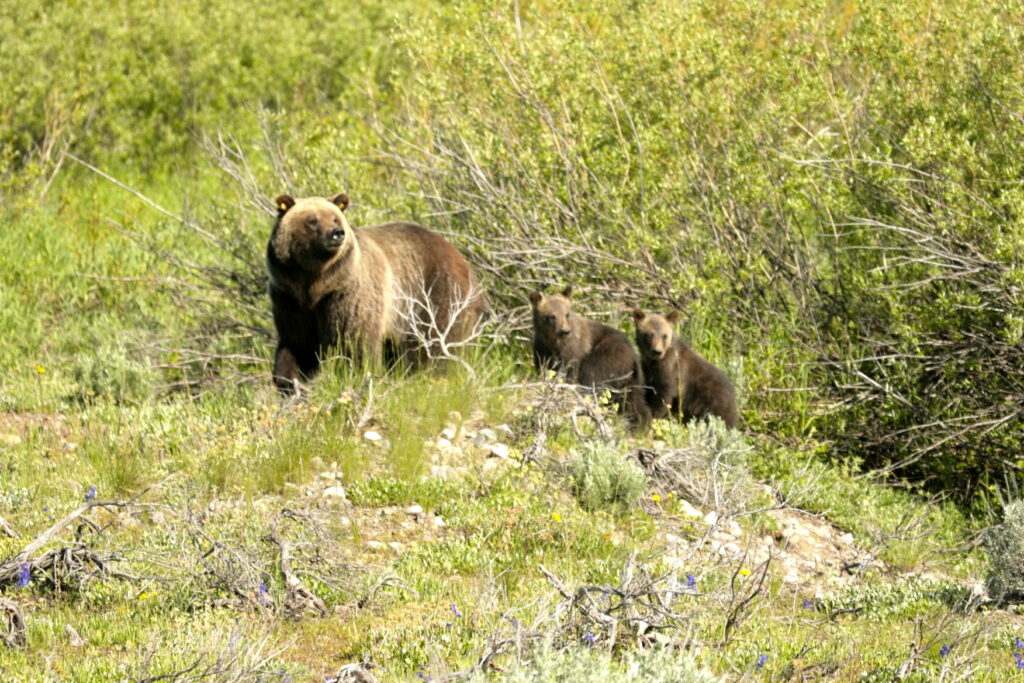Making the most of opportunities that allow people to safely and respectfully observe bears in the wilds of Grand Teton and Yellowstone National Parks is a special part of what we do through Wildlife Expeditions at Teton Science Schools. And it’s safe to say that no one forgets the experience of seeing a grizzly in its natural habitat.
When most of us picture bears, we tend to place them in the ferocious carnivore category. While it’s true that bears will hunt large mammals like moose and elk, they are just as likely to fish for salmon, dig for roots, or munch on berries. They are more accurately categorized as omnivores, and plants tend to comprise a larger portion of their diet than animals. Researchers studying grizzlies to our north in Canada found that Alberta’s grizzly bears are 90% vegetarian, with berries turning out to be an important food source. Berries also happen to be a favorite with people.

In mid-July, both wildlife and humans across the Greater Yellowstone Ecosystem start heading to their favorite wild berry patches to look for the first ripe berries of the season. There are dozens of berry-producing plants in the ecosystem. Many of the early ripeners of late July and early August are the most delectable and sought out with great delight by bears, birds, and humans alike. A member of the blueberry family, huckleberries are the most beloved of these top-tier berries and have defied any attempt to grow under cultivation. This makes them a unique treat from the ecosystem. Locals will add a handful to smoothies or pancakes, and there are several competing claims for the greatest huckleberry milkshake around. Wild raspberries and alpine strawberries are equally delicious, but as the wild varieties are small and difficult to harvest, it is easier to grow them in a garden than harvest them from the wild.

As the sweet and flavorful options of midsummer are eaten or wither away, the second-tier berries become more popular among wildlife. These berries aren’t as tasty to humans, and perhaps not to the wildlife either, but are more abundant and easier to harvest. Serviceberries, chokecherries, and hawthorns are a solid harvest that bears rely upon year to year. In one good mouthful of hawthorn berries, a bear can get more calories than a more delicate bite from a huckleberry bush. Many second-tier berries are edible for humans, but require some doctoring to make them acceptable to our palate. Serviceberries are mealy and bland in texture, while chokecherries require a large amount of sugar to balance their sour taste.
In autumn, the third-tier berries provide a little extra nutrition for wildlife long after all the tastier berries are gone. Berries such as rose hips or snowberries have little caloric value, but for a bear, they are a useful eleventh-hour food source. A week or so of browsing on rose hips gives a grizzly that extra bit of calories it needs to survive hibernation. Birds such as the Bohemian Waxwing and Townsend’s Solitaire rely on these third-tier berries all winter. For us humans, they don’t provide a good trailside snack, but they offer a little color to the landscape as leaves begin to fall off the trees.

In the height of summer, thoughts of snow and cold are far from our human minds, but animals like bears are already preparing for winter. As one of the few species that hibernate to cope with the cold season, bears must ingest sufficient calories during summer and fall to get them through months of not eating. Remarkably, grizzly bears need to eat about 20,000 calories a day in the late summer/fall months leading up to hibernation. Something to marvel at the next time you’re foraging for wild berries. And of course, remember to leave some for those hungry bears!


